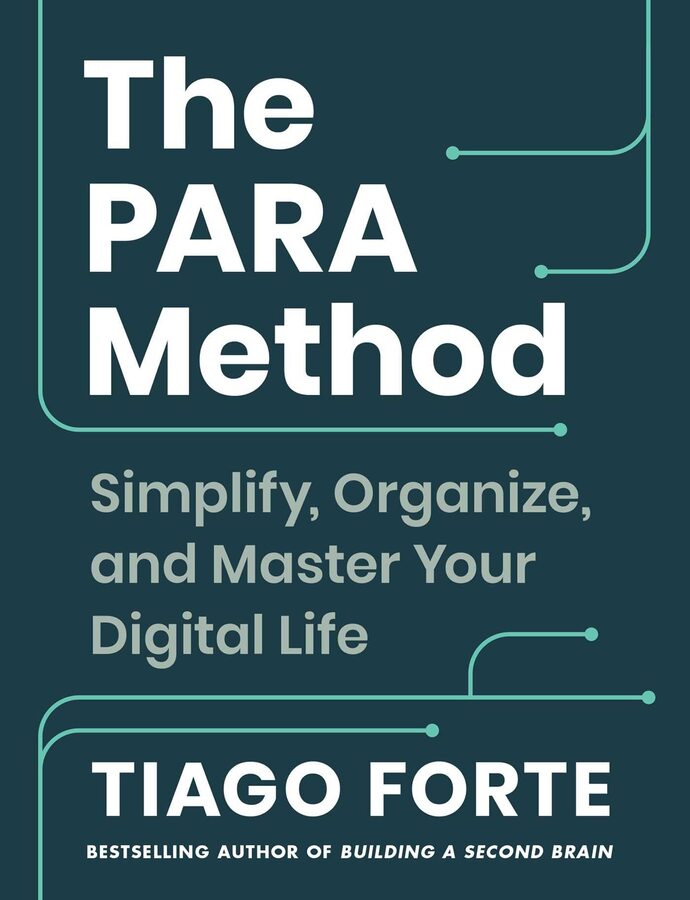Tiago Forte's first book, Building a Second Brain, was a hit for me. It is written well, has practical advice, and is useful to me. I've improved my processes in life according to concepts in the book and it truly improved my life.
After reading it, I followed the author's newsletter as well. Although I don't see all the content he publishes across his platforms, I've found some of it useful.
When The PARA Method was released, I was very excited to read it and bought it in the bookstore the next day. I wish I could say that I loved it.
about The PARA Method

This accessible guide expands upon the “well-written, cogent, and useful” (David Allen, author of Getting Things Done ) bestselling Building a Second Brain with actionable advice on how to improve your digital life in just a few minutes.
Living a modern life requires juggling a ton of information. But we were never taught how to manage this information effectively so that we can find what we need when we need it. In The PARA Method, Tiago Forte outlines a simple and intuitive four-step system that will help us sort all the information flooding our brains into four major categories—Projects, Areas, Resources, and Archives—allowing us to manage our commitments while achieving our goals and dreams.
- P rojects are specific, short-term efforts that you are actively working on with a certain goal in mind, such as completing a website or renovating your bathroom.
- A reas are the larger, ongoing areas of responsibility (health, finances, etc.) that encompass those specific projects.
- R esources include content on a range of topics you’re interested in or that could be useful for your projects and areas.
- A rchives include anything from the previous three categories that is now inactive, but you want to save for future reference.
With his easy-to-understand and engaging voice, Forte outlines his best practices and tips on how to successfully implement PARA, along with deep dives on everything from how to adopt habits to stay organized to how to use this system to enhance your focus. The PARA Method can be implemented in just seconds but has the power to transform the trajectory of your work and life using the power of digital organization.
my review
Firstly, The PARA Method is a small book. Its size is smaller than the regular paperback and has only 195 pages. Many of the pages are illustrations or big-sized quotes which is clearly a gimmick to increase the number of pages. Hence, the book has significantly less information.
Small books aren't always bad. I've read and loved Show Your Work! by Austin Kleon which is smaller than The PARA Method. It also has illustrations and big quotes with fewer total pages. But its content was highly valuable. Going with that thought, I didn't rule out The PARA Method's value before reading it.
You will always need to use multiple platforms to do your work.
The first five chapters are almost a repeat of what was in Building a Second Brain. Even if you've read or watched the author's online content on the PARA method, you will find the beginning a repetition. However, I understand that it is necessary for new readers who haven't come across Forte or this concept before.
The second section of the book deals with the questions we face when using the PARA method daily. What's the difference between Projects and Areas? What's the difference between Areas and Resources? How to know where to put information and when to move it around? This, again, is something for new readers.
I was looking forward to one chapter in the second section about using the PARA method as a team. As someone who works with a lot of information across my notes and documents written by others in my organization, I was looking for something helpful that I could suggest or implement at work.
Unfortunately, the chapter didn't tell me anything that I didn't deduce on my own already. It promoted the use of the method and that documentation should be a bottom-up approach at work, and that's it. The author has written it from a basic team's point of view according to how his team works and not necessarily thinking of different possibilities.
If information is a core part of your job, you will know that maintaining information is the biggest problem in shared documentation, not the writing or initial organization of documents. This wasn't touched at all in the book. I was so unsatisfied that I googled the topic and found this article which was a tad better than the book's chapter but still has the assumption that all teams and projects work like his.
There is nothing as constant as change in today's world, which is why we need to avoid rigid systems that encourage fixed mindset toward information.
A lot of the information in the book is reused from the author's other works. One section was copied directly from Building a Second Brain and many others were reworded from his blog posts and YouTube videos. I know that "reusing ideas" is one of the benefits of his method of note-taking but I don't think it should mean reusing like this.
The book wasn't bad, though. It wasn't great but it wasn't the absolute worst.... until the last section.
This is what really annoyed me: in the index, the last section is titled "bonus: FAQs." However, when I get to it, it's literally just one page asking the reader to download the PDF from the author's website. To actually get it, we have to sign up to his newsletter.
Since I was already on the list, I used my email and got the PDF. It was a list of simple FAQs answered that could have easily been added to the book. At the end of the PDF, the reader is pitched the author's paid course. So, in a way, this was a way to literally get emails and generate more money.
I appreciate hustlers when they do it in a valuable way. If I'm given really helpful information, I don't mind signing up to a newsletter and being pitched more things. But when the initial item is useless, why would I care about the rest? This book was written with a content creator's point of view and not a long-lasting book's author point of view. It seriously could have been shortened to a blog post that links and sells other things at the end.
A book has to stand tall on it's own without support from the author's various services. It has the potential to last beyond the author's lifetime and be his legacy. It felt like the team who worked on this book forgot about that.
overall
For someone who has never heard of the PARA method and hasn't come across the author before, this book would be mildly useful. However, Building a Second Brain is much better and makes this book pointless because it contains most of this and much more.
Maybe the author was on a contract to write another book and quickly put this together using the rest of his content. I don't know. Good quotes here and there don't make a book invaluable. I don't think this needed to be published and I doubt it will last long.
I don't recommend it.
chat with me!
Have you been disappointed by an author whom you loved before? What do you think of the current trend of content creators writing non-fiction books? What do you think of the books? Tell me in the comments!

That's disappointing! I don't mind if an author wants to promote their other work but it should either have been an FAQ that pitched his paid course OR a more substantial FAQ if you sign up to his mailing list. Now it sounds like he tried to get you to buy twice - once for the "free" FAQ and the second to convert your attention into money